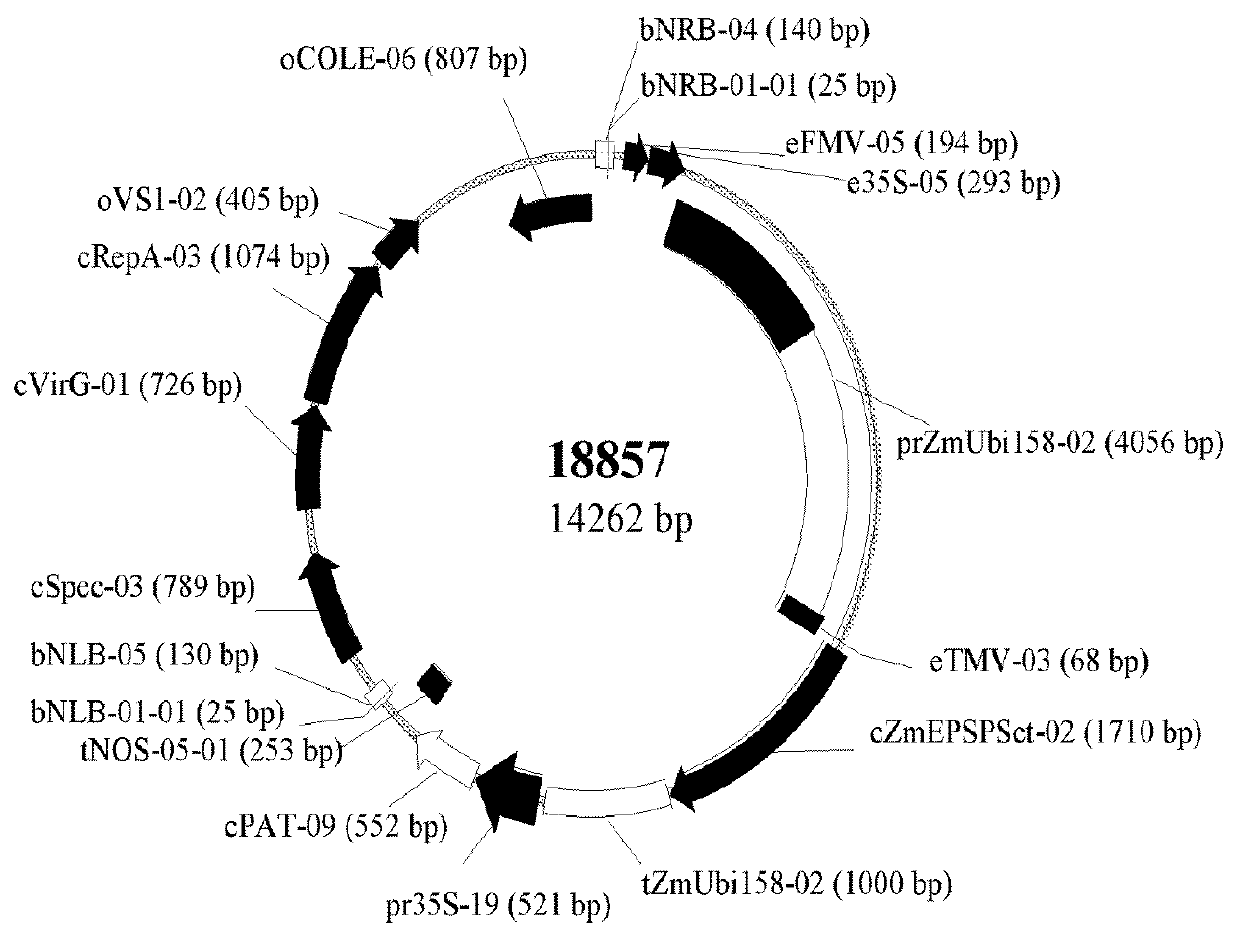Nucleic acid construct for conferring herbicide tolerance in plants
a technology of nucleic acid and constructs, which is applied in the direction of acyltransferases, biochemistry apparatus and processes, enzymes, etc., can solve the problems of reducing the effectiveness of herbicides, difficult to recover fully male-fertile, and potent inhibitors of gs, etc., to achieve enhanced herbicide tolerance
- Summary
- Abstract
- Description
- Claims
- Application Information
AI Technical Summary
Benefits of technology
Problems solved by technology
Method used
Image
Examples
example 1
s Synthesized
[0105]Five binary vector constructs were constructed with differing combinations of transcriptional enhancers, promoters, translational enhancers, and terminators, and variants of these genetic elements, driving expression of the genes encoding ZmEPSPS and PAT. All promoters used are known to be strong constitutive promoters, and the addition of the transcriptional and translational enhancers were expected to result in transgenic plants with excellent levels of expression and herbicide tolerance. Table 1 shows the five constructs created, and lists the genetic elements with each gene of interest (GOI). Table 2 describes each of the genetic elements named in Table 1.
[0106]
TABLE 1Composition of Binary ConstructsConstructTranscriptionalTranslationalIDenhancerPromoterenhancerGOITerminator17869eFMV-03:e35S-prAct1-07eTMV-02cZmEPSPSct-01t35S-08:tNOS-0505-01eNOS-01prUbi1-18cPAT-03-02t35S-08:tNOS-05-0118472eFMV-03:e35S-prCMP-08eTMV-02cZmEPSPSct-01tNOS-05-0105:eNOS-01pr35S-04cPAT...
example 2
ation Efficiency
[0108]Each of the five binary vector constructs was used to create maize transgenic events. Events were produced by Agrobacterium-mediated transformation of a proprietary maize line. Immature embryos were transformed essentially as described in Negrotto et al. (2000, Plant Cell Reports 19: 798-803). Using this method, genetic elements within the left and right border regions of the transformation plasmid were efficiently transferred and integrated into the genome of the plant cell, while genetic elements outside these border regions were not transferred.
[0109]The PAT gene was used as a selectable marker during the transformation process (Negrotto et al. 2000). The embryos producing embryogenic calli were transferred to a series of cell culture selection media containing bialaphos as selection agent and cultured for 10-11 weeks in total. The selection media contained 200 mg / ml timentin and / or 10 ml / l PPM (Plant Preservative Mix) to ensure that the Agrobacterium was cl...
example 3
ession Determined by Quantitative Sandwich ELISA
[0113]EPSPS and PAT gene expression were determined by immunoassay, specifically by quantitative sandwich ELISA for the detection of PAT or for the detection of EPSPS. Protein extract samples were prepared from two ¼ inch maize leaf punches sampled into 96-well blocks, which were then macerated, clarified, and diluted in ELISA diluent (PBS containing 1% BSA, 0.05% Tween-20).
[0114]For the quantitative ELISA sandwich for the detection of EPSPS, one polyclonal antibody produced against the rice EPSPS protein and one monoclonal antibody produced against the soy EPSPS protein were used. Standards (160, 80, 40, 20, 10, 5, 2.5, and 0 ng / ml of purified mEPSPS protein) were prepared in ELISA diluent. Donkey anti-mouse conjugated to alkaline phosphatase (Jackson ImmunoResearch, West Grove, Pa.) and the substrate p-nitrophenyl phosphate (Surmodics) were used for detection and quantification. The absorbance was measured at 405 nm using a microplat...
PUM
| Property | Measurement | Unit |
|---|---|---|
| temperature | aaaaa | aaaaa |
| temperature | aaaaa | aaaaa |
| Tm | aaaaa | aaaaa |
Abstract
Description
Claims
Application Information
 Login to View More
Login to View More - R&D
- Intellectual Property
- Life Sciences
- Materials
- Tech Scout
- Unparalleled Data Quality
- Higher Quality Content
- 60% Fewer Hallucinations
Browse by: Latest US Patents, China's latest patents, Technical Efficacy Thesaurus, Application Domain, Technology Topic, Popular Technical Reports.
© 2025 PatSnap. All rights reserved.Legal|Privacy policy|Modern Slavery Act Transparency Statement|Sitemap|About US| Contact US: help@patsnap.com

